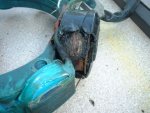Re: How to test ignition side of a stator
Normally, the only reason the stator would melt down on that model engine would be if the charging system rectifier had failed for some reason. If you have a tachometer and it works properly, the charging system including the rectifer is okay. The rectifier can be tested as follows.
(Small Rectifier Description & Location)
(J. Reeves)
On most 2,3,4,6 cylinder engines, the small rectifier is located on the starboard (right) side of the engine just in front of the engines electrical wiring strip. There are a few older V4 engines that have the wiring strip on the rear portion of the engine and the rectifier would be located just under that terminal strip. The smaller horsepower engines usually have the rectifier located on the starboard side of the powerhead close to the carburetor area.
The rectifier appears to be a round object approximately one inch (1") in diameter and also about one inch (1") high. The base of it is sort of triangular in appearance and is attached to the engine with two (2) screws/bolts..... usually one screw/bolt is larger than the other. The rectifier, depending on which one your engine uses, will have either:
One Red wire, one Yellow wire, and one Yellow/Gray wire, or One Red wire, and two Yellow wires.
Note that either of the above rectifiers could have a fourth wire which would be Yellow/Blue
********************
(Small Rectifier Test)
(J. Reeves)
Remove the rectifier wires from the terminal block. Using a ohm meter, connect the black lead of the ohm meter to the rectifier base (ground), then one by one, connect the red lead of the ohm meter to the yellow, yellow/gray, then the red wire (some rectifiers may also have a fourth yellow/blue wire. If so connect to that also). Now, reverse the ohm meter leads and check those same wires again. You should get a reading in one direction, and none at all in the other direction.
Now, connect the black lead of the ohm meter to the red wire. One by one, connect the red lead of the ohm meter to the yellow, yellow/gray, and if present, the yellow/blue wire. Then reverse the leads, checking the wires again. Once more, you should get a reading in one direction and none in the other.
Note that the reading obtained from the red rectifier wire will be lower then what is obtained from the other wires.
Any deviation from the "Reading", "No Reading" as above indicates a faulty rectifier. Note that a rectifier will not tolerate reverse polarity. Simply touching the battery with the cables in the reverse order or hooking up a battery charger backwards will blow the diodes in the rectifier assy immediately.




















